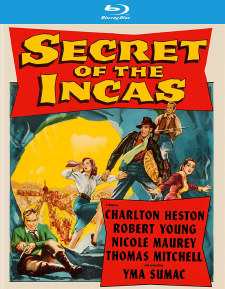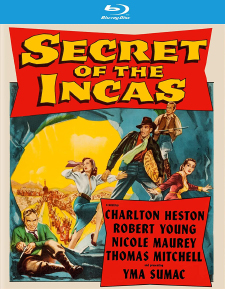Secret of the Incas (Blu-ray Review)

Director
Jerry HopperRelease Date(s)
1954 (February 28, 2023)Studio(s)
Paramount Pictures (Kino Lorber Studio Classics)- Film/Program Grade: B-
- Video Grade: B+
- Audio Grade: A-
- Extras Grade: B-
Review
Some years ago, an enterprising lad (or, perhaps, lass) created what was purported to be a trailer for a 1951 film of Raiders of the Lost Ark. Most of the footage was actually lifted from Secret of the Incas (1954), a forgotten Paramount release starring Charlton Heston, but the clever and amusing video (which you can see here) renewed interest in the forgotten film among movie buffs, many wrongly assuming it a proto-Indiana Jones-type action film packed with breathless adventure like Steven Spielberg’s film.
It’s probably true that Secret of the Incas did influence the 1981 production of Raiders of the Lost Ark in some respects—Heston’s wardrobe is remarkably similar to Harrison Ford’s, and there’s a scene in an ancient temple where treasure is pinpointed with a beam of light acting as a key to its location, as in Raiders. And while it’s likely the makers of Raiders, a Paramount film like Secret of the Incas, certainly would have had access, the 1954 film is singularly short on action and, in fact, is quite static and talky most of the time. However, it’s unusual and interesting in other ways that make it worth seeing, once anyway.
Heston plays American mercenary Harry Steele, working as a tour guide in Cusco, Peru. Unusual for a ‘50s hero, he’s unshaven and even slovenly, bluntly asking for tips for every little thing and flirting with the female American tourists (more tips), including starry-eyed Miss Morris (a very young Marion Ross of Happy Days) and even middle-aged Mrs. Winston (‘30s Warner Bros. star Glenda Farrell), with whom he exchanges some surprisingly dirty double-entendres.
In fact, Steele is biding his time there, planning on making his fortune by locating (and likely stealing) the “Sunburst,” a legendary Inca treasure made of gold and encrusted with rare gems. Steele already has in his possession the missing piece of a stone map revealing its location within the ruins of Machu Picchu, but has no means to travel to that remote locale. Also looking for the Sunburst is shady character Ed Morgan (Thomas Mitchell), who tries to scare Steele off by hiring a man to take pot shots at Steele through his hotel window.
Both complicating matters and providing the transportation Steele needs is Romanian defector Elena Antonescu (French actress Nicole Maurey), who is trying to make her way to the United States and freedom. Steele offers to help her, ostensibly to steal the small aircraft used by Romanian official Anton Marcu (Leon Askin). After a long journey to Machu Picchu, the couple arrives only to discover Inca descendants and archeologist Dr. Stanley Moorehead (Robert Young) already there, he doubtful of the existence of the Sunburst but in the process of unearthing the tomb where it may be hidden.
Competing with the popularity of television, a growing number of Hollywood productions were by the 1950s filming movies in far-flung locations, with Secret of the Incas shot on location in Peru. A 16-man unit including director Jerry Hopper and Heston spent a month filming prime footage in Cuzco and at Machu Picchu which, as noted in the film, are at elevations of 11,200 and nearly 8,000 feet, respectively, causing altitude sickness in many of its visitors.
It’s rather amazing a Hollywood film crew was pretty much allowed to run rampant over the 15th century Inca citadel, later a UNESCO site and, beginning in 2023, off-limits to the general public entirely. For years it was a dangerous tourist stop, prone to landslides, earthquakes, hiking accidents and death related to altitude sickness. Of course, interiors of the temple (in reality, it was a royal estate) and many exteriors were recreated on Paramount’s soundstages, but the careful editing creates a reasonable illusion.
The talky script by Sydney Boehm and Ranald MacDougall hurts the film, which is starving for more action and suspense, it focusing instead on Steele’s innate cynicism and mercenary veneer. It was unusual in a 1950s Hollywood film to build a story around such an unlikable antihero. Heston would come to specialize in such characters when the vogue for historical and biblical epics went into decline after the mid-1960s, so it’s interesting to see him tackle such a part when his screen persona was still forming. This was only his 10th Hollywood feature, and Paramount, Heston under contract there though not exclusively so, seemed uncertain how to utilize him. His biggest success up to that point was playing the hard-nosed circus manager of The Greatest Show on Earth for Cecil B. DeMille, Heston so authentic some moviegoers thought he was a real circus manager acting among the Hollywood veterans. Heston’s performance influenced the types of roles offered him for the next several years. Reportedly Billy Wilder wanted Heston for the lead in Stalag 17, but the studio insisted on William Holden, Hollywood’s go-to guy for similarly sardonic parts.
Conversely, Secret of the Incas was one of the few times Thomas Mitchell, lovable Uncle Billy in It’s a Wonderful Life, played an outright villain. He’s fine, though a specialist of such parts would have brought more color to the part than Mitchell is able. Robert Young, on the other hand, though perfectly fine performance-wise, seems utterly out of place as a straight-laced, naïve scientist; he’s like a character from another movie amid all the scheming types, which include even Maurey’s Elena, who uses her beauty to travel about the continent. She appeared in some major French films such as Diary of a Country Priest but was never a big star there. In the U.S. and Britain, she appeared in a wide range of films, as varied as The Jayhawkers! and The Day of the Triffids. After 1970, she spent the rest of career mainly on French television.
Adding additional interest is the rare film appearance of Peruvian vocalist Yma Sumac, the “Queen of Exotica,” a pioneer of world music with an incredible 4½ to 5-octave vocal range. Cast as an Incan native, her musical numbers are rather jarringly out of place story-wise, but her singing is uniquely remarkable.
I have a 2019 Japanese Blu-ray from several years back, presumably using the same inadequate video transfer used by Australia’s Imprint label for their release some time later. That transfer was marred by frequent color misalignment and had other issues, while Kino’s new Blu-ray is a “4K scan of the 35 mm YCMs.” There are no misalignment issues this time, the image impressively sharp, though opticals like dissolves from one scene to the next are much softer. Curiously, the earlier transfer had more vivid color. Given that the YCMs should render dead-on accurate hues, it’s unclear why this is. Paramount’s house style favored an almost burnished oversaturation on its early ‘50s Technicolor releases (see War of the Worlds as an example of this), so why does the color on Secret of the Incas feel so color-drained? Did the telecine operator feel the color too rich? Was it the result of the film stock/processing done in South America? I can offer no answer.
The English DTS-HD Master Audio (2.0 mono) is better, slightly, than the earlier transfer, and supported by optional English subtitles. The disc is Region “A” encoded. The lone special feature is a fact-filled audio commentary track by film historian Toby Roan.
Secret of the Incas is a little disappointing with too much talk and not enough action; at times it’s even a little dull. But there’s enough there to make it worthwhile viewing. Recommended.
- Stuart Galbraith IV

